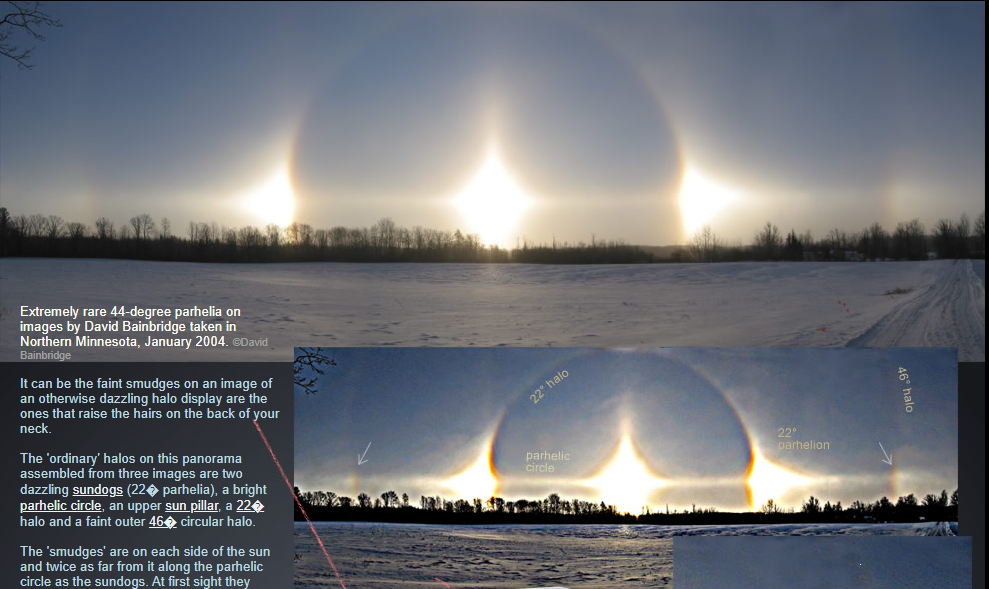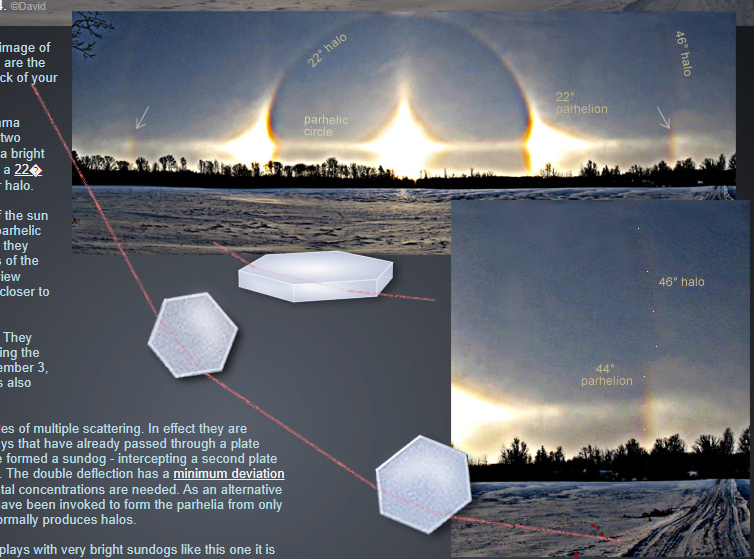44-degree Parhelia
Exploring the Enigma of 44-Degree Parhelia
Have you ever come across a mesmerizing image where faint smudges, seemingly insignificant in the grand scheme of things, manage to captivate your attention? One such phenomenon that can elicit such a reaction is the elusive 44-degree parhelia. These rare optical phenomena have been observed and documented on a few occasions, leaving scientists and enthusiasts in awe of their mysterious nature.
In an image captured by David Bainbridge in Northern Minnesota in January 2004, these extraordinary 44-degree parhelia were beautifully showcased. Alongside other remarkable atmospheric optics, such as sundogs, parhelic circles, sun pillars, and the more commonly seen 22-degree halo, these faint smudges stood out as intriguing anomalies.
At first glance, these smudges appear to be brighter fragments of the 46-degree halo encircling the sun. However, upon closer examination, it becomes evident that they are closer to the sun itself. These smudges are none other than the legendary 44-degree parhelia, which were first photographed during the renowned Saskatoon display of December 3, 1970.
The occurrence of 44-degree parhelia is a rare example of multiple scattering. In essence, they can be described as "sundogs of sundogs." Rays of light that have already passed through a plate crystal, which would typically form a sundog, intercept a second plate crystal and undergo further deflection. This double deflection results in a minimum deviation angle of 44 degrees. It is important to note that very high concentrations of plate crystals are required for this phenomenon to manifest.
Alternatively, some scientists have proposed peculiar geometries as an explanation for the formation of parhelia solely through single crystal scattering, which is the usual process that gives rise to halos. Further research is necessary to fully comprehend the mechanisms at play in the creation of these enigmatic 44-degree parhelia.
For avid observers of atmospheric optics, it is highly recommended to routinely check and photograph the sky twice as far from the sun when observing diamond dust displays with exceptionally bright sundogs. These additional observations may unveil even more intriguing phenomena, such as "reflected" Lowitz arcs and 46-degree contact arcs, as potentially seen in the Minnesota images.
The study and documentation of atmospheric optics continue to fascinate researchers and enthusiasts alike. The discovery of rare phenomena like the 44-degree parhelia serve as reminders of the vast complexity and beauty that can be found in our atmosphere. As we strive to unlock the secrets of these optical marvels, we are constantly reminded of the wonders that surround us, waiting to be observed and understood.
Note: This article has been automatically converted from the old site and may not appear as intended. You can find the original article here.

Extremely rare 44-degree parhelia on images by David Bainbridge taken in Northern Minnesota, January 2004. ©David Bainbridge
It can be the faint smudges on an image of an otherwise dazzling halo display are the ones that raise the hairs on the back of your neck.
The 'ordinary' halos on this panorama assembled from three images are two dazzling sundogs (22� parhelia), a bright parhelic circle, an upper sun pillar, a 22� halo and a faint outer 46� circular halo.
The 'smudges' are on each side of the sun and twice as far from it along the parhelic circle as the sundogs. At first sight they could simply be brighter fragments of the 46� halo but the enlarged lower view shows that they are not. They are closer to the sun.
They are the fabled 44� parhelia. They were previously photographed during the famous Saskatoon display of December 3, 1970 (during which a Kern arc was also reported but not photographed).
The 44� parhelia are rare examples of multiple scattering. In effect they are 'sundogs of sundogs' formed by rays that have already passed through a plate crystal - and would otherwise have formed a sundog - intercepting a second plate crystal and being further deflected. The double deflection has a minimum deviation angle of 44�. Very high plate crystal concentrations are needed. As an alternative explanation, peculiar geometries have been invoked to form the parhelia from only the single crystal scattering that normally produces halos.
When observing diamond dust displays with very bright sundogs like this one it is well worth routinely checking - and photographing - the sky twice as far from the sun.
As if 44� parhelia were not enough, the Minnesota images possibly also show 'reflected' Lowitz arcs and 46� contact arcs.

Note: this article has been automatically converted from the old site and may not appear as intended. You can find the original article here.
Reference Atmospheric Optics
If you use any of the definitions, information, or data presented on Atmospheric Optics, please copy the link or reference below to properly credit us as the reference source. Thank you!
-
<a href="https://atoptics.co.uk/blog/44-degree-parhelia/">44-degree Parhelia</a>
-
"44-degree Parhelia". Atmospheric Optics. Accessed on December 23, 2024. https://atoptics.co.uk/blog/44-degree-parhelia/.
-
"44-degree Parhelia". Atmospheric Optics, https://atoptics.co.uk/blog/44-degree-parhelia/. Accessed 23 December, 2024
-
44-degree Parhelia. Atmospheric Optics. Retrieved from https://atoptics.co.uk/blog/44-degree-parhelia/.